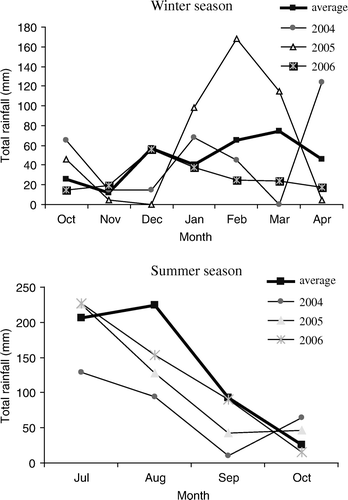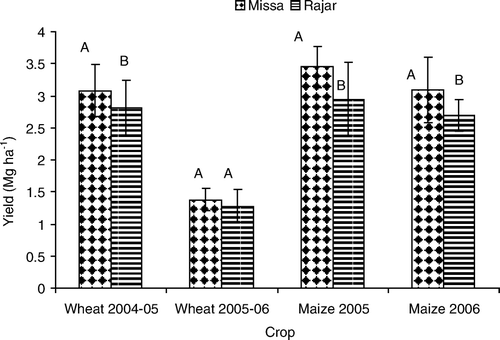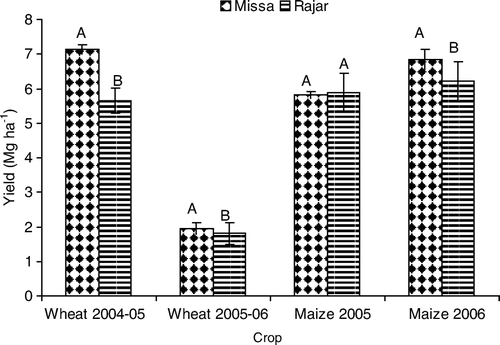Abstract
Cultivated lands in erosion prone agro-ecologies incessantly experience a substantial loss of productive soil and organic matter. Currently, the fertility-management and rainwater-conservation practices are given emphasis separately. This study appraised collectively both the water-conservation and fertility-management practices for the restoration of soil productivity in eroded farmlands. Field experiments were carried out on wheat (Triticum aestivum L.) and maize (Zea mays L.) in eight farmer fields. Four fields of Missa soil series (Typic Ustochrept) and four of Rajar soil series (Typic Ustorthent) were selected. Treatments in each field were: farmers' practice as control without soil-water conservation, and with farmers' rate of fertilizer (per hectare 40 kg N + 30 kg P2O5); improved fertilization (per hectare 100 kg N, 60 kg P2O5, 2 kg Zn, and 1 kg B) without soil-water-conservation practices; soil-water-conservation practices (deep plowing, bund improvement, ploughing across the contour) + farmers' rate of fertilizers; and soil-water conservation + improved fertilization. Crop grain yields were at the highest with soil-water conservation + improved fertilization (per hectare wheat 3.31 Mg and 1.65 Mg in 2004–2005 and 2005–2006; and maize 4.55 Mg and 4.19 Mg in 2005 and 2006, respectively). The lowest yields were recorded under farmers' practice for both crops. Similar was the response for water-use efficiency and plant uptake of nitrogen, phosphorus, zinc, and boron. Missa soil series was more responsive than was Rajar to integrated soil-management practices. Synergistic application of soil-water conservation and improved fertilization practices significantly improved the crop yields, nutrient uptake, and water-use efficiency.
Introduction
In rainfed cultivated areas of Pakistan, owing to a lack of appropriate research there is only a slow pace of development compared with irrigated areas. For poverty alleviation and achieving a sustainable system of food production, there is need of an integrated approach to conserve both soil and water. The Pothwar plateau (latitude 32° 10′ to 34° 9′ N, longitude 71° 10′ to 73° 55′ E) in the northern part of Punjab province is a large rainfed agricultural tract of Pakistan spanning over 1.82 million hectares. This area has a flat to gently undulating topography, locally broken by gullies and low hill ranges. The parent material mainly consists of loess, residual mantle on sandstones and shale bedrocks, narrow strips of river alluvium, and piedmont alluvium near the foot of mountains (Nizami et al., Citation2004).
Crops like sorghum, maize, and wheat are grown mainly in rainfed areas, and yields of these crops are much less than their potential. During 2006–2007 wheat was cultivated on an area of 1.24 million hectares in rainfed area and the yield obtained was 1.53 Mg ha−1 while the total area under wheat crop was 8.58 million hectares and yield produced was 2.72 Mg ha−1. During the same year, total area (irrigated and rainfed) under maize cultivation was 1.02 million hectares and yield production was 3.04 Mg ha−1 (NFDC, Citation2008). The productivity of rainfed crops is quite low, which is mainly attributed to soil moisture stress at critical plant-growth stages and low soil fertility. There are widespread deficiencies in all the major nutrients (Rashid et al., Citation1997a, Citation1997b). In rainfed eroded areas the multiple nutrient deficiencies have resulted in nutrient imbalances as well as poor nutrient-use efficiencies of added fertilizers (NFDC, Citation2000). Most soils are alkaline and calcareous, inducing low availability of P and micronutrients. The imbalance in use of fertilizers further enhances the deficiencies of nutrients. A nutrient-indexing survey of wheat in Pothwar indicated that 70% of fields were deficient in N, 67% in P, 20% in K, 64% in B, and 70% in Zn (Rashid, Citation1994). Shafiq et al. (Citation2003) reported that 100% of soil samples collected from typical water-eroded soils on the Pothwar plateau were deficient in N and P while 95% and 85% of soil samples were found to be deficient in Zn and B, respectively. Even worldwide, Zn and B deficiencies are widespread in calcareous soils of arid and semiarid regions (Shorrocks, Citation1997; Sillanpaa, Citation1990).
On the Pothwar plateau, because of its relatively coarse texture and low organic-matter content, the surface structure is unstable. Crust formation reduces plant emergence and exposes soil surface to erosion. These soils have a distinct plough pan and, at places fragipan, which reduces both water-intake rate and root penetration that attempts to optimize use of subsoil nutrients and moisture (Nizami et al., Citation2004). On the Pothwar plateau about 50% of farmers practice deep ploughing before the onset of the monsoon season (July–September). However, other water-conservation practices like land forming, improvement of field bunds, and contour ploughing are not being adopted, with the result that deep ploughing was not effective for rainwater conservation. The type of tillage used to conserve soil water depends upon both weather and soil conditions. Some methods of water-erosion control include contour tillage that prevents runoff, and deep tillage that disrupts soil layers impeding water infiltration.
Deep tillage is an effective technique for rainwater conservation (Bennie & Botha, Citation1986), and crop yields can be improved by balanced application of fertilizers in eroded soils (Izaurralde et al., Citation2006). However, the strategy for increasing crop yields and sustaining them at a high level must include an integrated approach. Soil conservation may not have an immediate effect on crop yields, depending largely on soil losses resulting from continuous erosion. For long-term productivity, erosion control is essential. Earlier studies put an emphasis on fertility management and rainwater-conservation practices separately, and application of fertilizers was not done according to the deficiency status of nutrients. So, the present study was planned with the objective to develop and disseminate rainwater- and nutrient-management techniques together for increasing and sustaining the productivity of eroded lands.
Materials and methods
Study site
The study was conducted in the Fatehjang tehsil area of Attock district on typical water-eroded soils of the Pothwar plateau located in the north of Punjab province, Pakistan during the years 2004–2006. The study area is located on both sides of the Rawalpindi–Fatehjang road and lies between 33° 30′ to 33° 50′ N and 72° 30′ to 72° 50′ E. It falls in the sub-humid warm subtropical agro-ecological zone. Eight sites (farmers' fields) were selected to conduct the experiment; four belonging to Missa and four to Rajar soil series. These soils have been classified into soil series according to the Soil Survey Manual (USDA, Citation1951). The Missa soils are moderately eroded and Rajar soils are severely eroded. Nizami et al. (Citation2004) defined and identified the water-erosion classes according to the Soil Survey Manual (USDA Handbook No. 18). In moderately eroded land (1–2% slope) the soil has been eroded to an extent that ordinary tillage implements reach the B horizon. Generally, a part of the B horizon is washed away. In severely eroded land (3–4% slope) the plough layer consists essentially of materials from lower parts of the B horizon or other underlying horizon.
Climatic conditions
Winter rainfall in wheat season
The rainfall data of Fatehjang for the years 1988–2003 (averaged) and experimental years (2004–2006) are shown in a. It indicates that year 2004 received more rainfall than average in October and November. The year 2005 had more rainfall than average from January to March but less in April. The data revealed that wheat season 2004–2005 was a wet year and received more rainfall. Similarly, year 2005 received more rainfall than average during October and year 2006 received less rainfall than average from January to April. In this way, the wheat season 2005–2006 received comparatively low rainfall.
Summer rainfalls in maize season
The data revealed that rainfall received during maize season 2005 and 2006 in July was more than the average of last 15 years, but it was lower in the months of August, September, and October. Generally, the rainfall distribution during maize season was satisfactory according to crop needs, although not even, during both years (b).
Soil characteristics
Pre-sowing characteristics of soils under our experiment showed that experimental areas were slightly alkaline with high free lime contents but there was no salinity problem (). Guidelines of Ryan et al. (Citation2001) were followed for interpreting soil nutrient status. Organic-matter content was low and in the deficient range. Concentrations of NO3-N, P, and K were relatively higher in Missa than in Rajar soil series. All the sites were deficient in NO3-N, P, Zn, and B. These soils contained a higher percentage of silt particles, as these soils were mainly derived from loess and sandstone parent material. Missa soil series has a constituency of 12% sand, 66% silt, and 22% clay while Rajar soil series consists of 10% sand, 59% silt, and 31% clay.
Table I. Basic characteristic of the original soils under experiment; ±standard deviation of the mean.
Experiment design and treatments
The experiment was a randomized complete-block design having four replications for each treatment. There were four fields (replications) each of Missa soil series and Rajar soil series. One farmers' field was considered as one replication in each soil series. In this way there were four replications of Missa soil series and four of Rajar soil series. In each field/replication four treatments were applied. Description of the treatments is as follows:
T1 Fertilizer application according to farmers' practice (FP) as: 40 kg N ha−1+30 kg P2O5+no soil-water-conservation (SWC) practices
T2 Improved fertilization (IF) as: fertilizers applied at the per-hectare rate of 100 kg N, 60 kg P2O5, 2 kg Zn, and 1 kg B + no SWC practices
T3 SWC as: deep plowing, bund improvement/raising, and contouring + FP (SWC + FP)
T4 SWC practices + IF (SWC + IF)
Fertilizer urea and diammonium hydrogen phosphate (DAP) were applied as the source of N and P, respectively, before the sowing of each crop. In improved fertilization treatments 50% N was applied as band placement and 50% was top-dressed. Phosphorus was also applied at the time of sowing by band-placement method. The Zn and B as zinc sulfate and borax were broadcasted for the initial (wheat 2004–2005 & maize 2005) two crops. In the control, fertilizers were applied according to farmers' practices of broadcasting both N and P before crop sowing.
Crop sowing
Wheat and maize were grown as winter and summer crops in rotation for two years of the study period, viz. 2004–2006. The growing season of wheat was from the end of October to the middle of April, and that of maize was the middle of July to the start of October. Before the onset of monsoon rains (July–September), soil was deep tilled with a chisel plough to a depth of 30 cm for all soil-water-conservation treatments. The wheat variety sown was Bhakhar 2000 and the seed rate was 100 kg ha−1, and seeds were sown with a hand-drill. Seed rate for maize was 40 kg ha−1 sown with a hand-drill, and the variety used was Neelum.
Data collection
A quadrate of 1 m2 was used for collection of plant samples from three sites in each treatment plot for obtaining data on grain and straw/stover yields. The quadrate was placed evenly over the plots, and uniformity across the plots was kept in consideration. After harvesting, the crop biomass was tied into bundles separately for each treatment and grains were threshed by a tractor-mounted thresher. Soil water contents in samples drawn at the time of sowing and after the harvest of each crop to a depth of 90 cm were measured gravimetrically by drying the soil at 105 °C (Gardner, Citation1986).
Water-use efficiency (kg ha−1 mm−1) was calculated as grain yield (kg ha−1) divided by total water supplied (mm). Total water supplied was calculated as shown in Equation (Equation1):
Crop uptake of nutrients (kg ha−1) by grain and straw/stover was calculated by following Equation (Equation2):
Total uptake of each nutrient by the individual crops was determined as the cumulative uptake in both grains and straw portions.
Soil and plant analysis
Composite soil samples were collected from selected experimental fields from topsoil (0–15 cm) and subsoil (30–45 cm). Pre-sowing soil analyses were carried out for texture (Bouyoucos, Citation1962), pH, and electrical conductivity (EC) in a suspension of soil-to-water ratio of 1:1 (McLean, Citation1982), CaCO3 (Soltanpour & Workman, Citation1981), organic matter (Nelson & Sommers, Citation1982), ammonium bicarbanete-diethylenetriaminepentaacetic acid (AB-DTPA)-extractable NO3-N, P, K, Zn, Cu, Fe, and Mn (Soltanpour Citation1985), and HCl-extractable B (Rashid et al., Citation1994). Data on these measurements are given in .
Analysis of plant samples (straw/stover and grains) taken at crop-harvest stage was carried out for the concentration of all those nutrients which were added in the treatments including total nitrogen (McKeague, Citation1978), phosphorus, zinc (Cottenie, Citation1980), and boron (Bingham, Citation1982). The uptake of these nutrients was calculated from their concentration in the plants as shown in the formula given above.
Statistical analysis
The data collected for various soil characteristics and plant parameters in response to the SWC and fertilizer treatments were subjected to analysis of variance using M-STAT C software. Statistical difference among treatment means for these parameters were determined with least significant difference at ≤ 0.05 probability level according to the procedures described by Steel et al. (Citation1997).
Results
Grain yield
The data of wheat and maize grain yield are presented in . The wheat 2004–2005 and 2005–2006 gave statistically nonsignificant difference of yield under IF and SWC + IF treatments. Compared with control, the increase in grain yield by SWC + IF was 28 and 68% for wheat 2004–2005 and wheat 2005–2006, respectively. The maize crops 2005 and 2006 gave statistically higher yield under SWC + IF and the percentage increase of yield was 169 and 118%, respectively, for maize 2005 and 2006. In the Missa soil series for all crops except wheat 2005–2006, a statistically higher yield was produced than at the Rajar soil series (). For wheat 2004–2005, a statistically higher yield (2.94 Mg ha−1) was produced than in wheat 2005–2006 (1.33 Mg ha−1). Maize crop 2005 gave statistically higher grain yield (3.20 Mg ha−1) than did maize crop 2006 (2.89 Mg ha−1).
Figure 2. Grain yield of wheat and maize under different soil-management practices; FP, farmers' practices; IF, improved fertilization; SWC, soil-water conservation. Vertical lines above each bar show standard deviation. Different uppercase letters indicate significant difference between the treatments at a level of P <0.05.
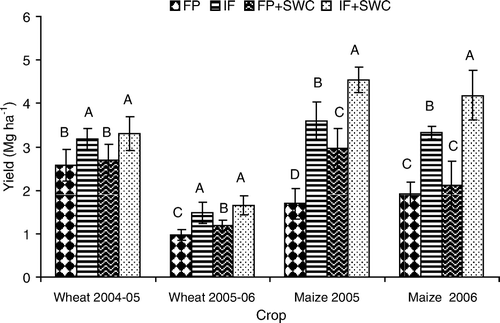
Straw/stover yield
The order of performance of treatments for straw/stover yield of wheat and maize was similar to that of grain yield (). Wheat 2004–2005 and maize 2005 showed a statistically nonsignificant difference between SWC + IF and IF. The percentage increase of straw yield under SWC + IF was 21 and 43% for wheat 2004–2005 and 2005–2006, respectively. The maize crops showed 44 and 40% increase in stover yield for maize 2005 and 2006, respectively, for SWC + IF. Missa soil series produced statistically higher yield than did Rajar soil series in wheat and maize crops, except for maize 2005 which showed nonsignificant difference (). The straw yield was significantly greater during year 2004–2005 (6.40 Mg ha−1) than during 2005–2006 (1.88 Mg ha−1). The maximum stover yield was recorded during 2006 (6.05 Mg ha−1) and it was statistically greater than in 2005 (5.86 Mg ha−1).
Figure 4. Straw/stover yield of wheat and maize under different soil-management practices; FP, farmers' practices; IF, improved fertilization; SWC, soil-water conservation. Vertical lines above each bar show standard deviation. Different uppercase letters indicate significant difference between the treatments at a level of P <0.05.
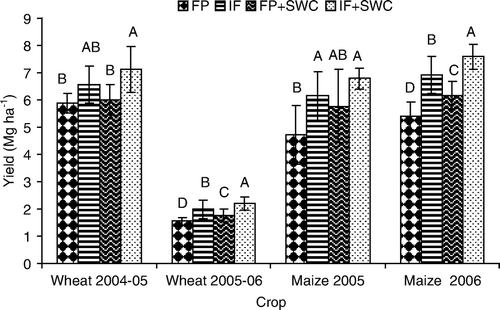
Uptake of nutrients
The average data of two years for total N and P uptake showed that, among the treatments, the SWC + IF regime gave the higher N and P uptake, followed by IF (). Missa soil series showed slightly higher N and P uptake than did Rajar soil series. Likewise, Zn and B uptake under SWC and FP was less than under improved and integrated treatments. Uptake of Zn and B shows that response of Missa soil series to all treatments was better than for Rajar soils. This was due to higher grain yield in Missa soil series than in the Rajar soil series (). Uptake of N, P, Zn, and B by maize was significantly higher with SWC + IF and IF (). The trend of results for various treatments was the same as in wheat uptake. There was a better uptake by Missa soils than by Rajar soils.
Table II. Nutrient uptake (kg ha−1) by wheat under different soil-management practices (average of two years' data).
Table III. Nutrient uptake (kg ha−1) by maize under different soil-management practices (average of two years' data).
Water-use efficiency
The water-use efficiency (WUE) for wheat as well as maize under various treatments is given in . The highest WUE was obtained in SWC + IF followed by improved fertilization (IF). The order of performance among all the treatments was SWC + IF > IF > SWC + FP > FP. Among the four crops, wheat 2004–2005 gave the lowest WUE- and maize 2006 had the highest WUE-values.
Figure 6. Water-use efficiency of wheat and maize under different soil-management practices; FP, farmers' practices; IF, improved fertilization; SWC, soil-water conservation. Vertical lines above each bar show standard deviation. Different uppercase letters indicate significant difference between the treatments at a level of P <0.05.
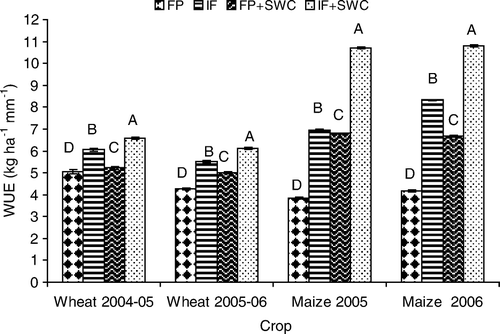
Discussion
The performance of SWC + IF in terms of yield, nutrient uptake, and WUE was significantly greater than that of other treatments. Higher yield under this practice was due to an interactive effect of both the soil-water conservation [deep tillage, contour sowing, and field boundary (bund) improvement] and fertility-management practices. Shafiq (Citation2007) advocated that in the typical water-eroded soils of the Pothwar plateau, use of only deep tillage without adopting other conservation practices was not enough to conserve rainwater. Other water-conservation practices, viz. improvement of bunds and contour ploughing, were equally important to make deep tillage effective in the Pothwar area. Therefore, in Pakistan, average yields of major crops are low at the farmer's level in comparison with that at research farms and in other countries (Government of Pakistan, Citation2008). Dai et al. (Citation2008) emphasized the supplementation of enough available nutrients in both the wheat and maize, especially during the active growth period of crops. In this study, a nonsignificant difference (P <0.05) in wheat grain yield under IF and SWC + IF for both years elucidated that water availability was enough in both treatments. This may be attributed to more infiltration of water and less runoff during winter rains (having low intensity compared with monsoon rains in summer). Significant response of maize grain yield to SWC + IF was due to deep tillage before crop sowing, which caused more infiltration of water.
Khan et al. (Citation1986) also reported that high yield in improved fertilization + soil-water conservation was attributed to deep tillage. Less rainwater runoff losses, contour sowing, land-boundary raising, and balanced fertilization could also be contributing factors. Owing to soil-moisture conservation water storage was higher in the soil profile. In the integrated treatment greater availability of soil water in the root zone profile may have enhanced root proliferation and the availability of nutrients. Among crop-production factors, shares in productivity range from 5–20% for tillage and 20–50% for fertilizer (Ahmad & Rashid, Citation2003). In addition to soil moisture, the availability of nutrients in the soil profile determines the crop yields (Patil et al., Citation2004). So, in the present study, yield obtained under only SWC or IF was less than with their integration as SWC + IF. For more effective and economical use of N fertilizer, Ahmad et al. (Citation2008) suggested integration of the N fertilizer at lower rates with N-enriched compost.
In SWC + IF treatment, balanced fertilization is another factor that gave higher yield, as deficiency of micronutrients causes yield reduction. On the Pothwar plateau, application of micronutrients is not a common practice. Asad & Rafique (Citation2002) found that total wheat grain yield was significantly depressed where micronutrients were deficient, and in the treatment where all micro- and macro-nutrients were applied but boron was not applied. Average yield increase in maize and wheat with B application was 20 and 14%, respectively (Rashid et al., Citation2006). Nutrient uptake and water-use efficiency were ultimately also higher in SWC + IF than with other treatments because the yield obtained was higher under this treatment. Izaurralde et al. (Citation1998) found changes in plant N uptake by wheat with varying levels of simulated erosion and N applied rates. Ishaq et al. (Citation2001) reported 14.3 kg ha−1 uptake of P with deep tillage. Chaudhary et al. (Citation2001) found that there was lower Zn uptake in the treatment without zinc. Asad & Rafique (Citation2002) found that boron concentration in the dry matter of wheat plants was increased with the addition of boron fertilizer.
In the present study, higher yield with SWC + IF was due to continuous supply of both water and balanced nutrients in the root zone. It increased the WUE with improved crop yield. Water-use efficiency depends upon physiological processes in plants, and these processes are affected by availability of nutrients. Any practice that leads to an increase in soil water in the root zone may have a positive impact on WUE, due to increased water availability and improved nutrient uptake (Hatfield et al., Citation2001). In a long-term tillage experiment on barley cropping, Zhang et al. (Citation2007) found that no-tillage increased the soil total organic C and N concentrations. Soil bulk density was lower under no-tillage than with disc tillage. Barley grain yield with no-tillage was better than that under disc tillage, and rate of N application increased grain yield up to 91 kg N ha−1.
On the Pothwar plateau, it is essential that both water and plant nutrient supplies are sufficient for meeting crop needs. High efficiency in the use of water is achieved only when crops have access to adequate supplies of nutrients according to their requirement. Thus, in SWC + IF treatment, increased available water improved the mass flow and diffusion of solutes in soils, which enhanced the nutrient uptake. During moisture-stress conditions the shortage of assimilates and the reduced availability of nutrients cause reduction of grain growth and duration of grain filling (Ren et al., Citation2003). In the present study during wheat 2004–2005 the yield was low due to drought conditions as this period of wheat received less rainfall than average (). Yield losses associated with drought at different growth stages of plant were also reported by Guttieri et al. (Citation2001).
Higher yield, nutrient uptake, and WUE were found under Missa soil series than in Rajar. This may be attributed to initially lower nutrient status of Rajar soil series than that of Missa, and due to difference of water-erosion classes. Missa soil series was moderately eroded and Rajar was severely eroded. Mokma & Seitz (Citation1992) reported significantly lower yield on severely eroded than on slightly and moderately eroded phases. Erosion makes the soil shallow and decreases the depth of soil to the restricting layer, which causes a decrease in available water-holding capacity (AWHC) of the soil and results in low yield. Jankauskas et al. (Citation2008) also reported a decrease in moisture-retention capacity with increased soil erosion. The AWHC, total N, and available P were among the most effective soil variables to barley production in the arid region of northern Iran (Ayoubi et al., Citation2009). Therefore, for storing more rainwater and making it available for plant uptake, erosion control and soil-fertility improvement are crucial. Adverse effects of erosion on crop yield and productivity can only be mitigated by adopting proper soil-water conservation and fertility-management practices as employed in this study.
Acknowledgements
This study was a part of the project undertaken by Water Resources Research Institute, National Agriculture Centre (NARC), Islamabad, Pakistan. The financial and personnel support along with laboratory facilities rendered by NARC are highly acknowledged.
References
- Ahmad , N. Rashid , M. 2003 . Fertilizers and Their Use in Pakistan . National Fertilizer Development Centre, Planning and Development Division, Government of Pakistan , Islamabad .
- Ahmad , R. , Naveed , M. , Aslam , M. , Zahir , Z.A. , Arshad , M. and Jilani , G. 2008 . Economizing the use of nitrogen fertilizer in wheat production through enriched compost . Renewable Agriculture & Food Systems , 23 : 243 – 249 .
- Asad , A. and Rafique , R. 2002 . Identification of micronutrient deficiency of wheat in the Peshawar valley, Pakistan . Communication in Soil Science & Plant Analysis , 33 : 349 – 364 .
- Ayoubi , S. , Khormali , F. and Sahrawat , K.L. 2009 . Relationships of barley biomass and grain yields to soil properties within a field in the arid region: Use of factor analysis . Acta Agriculturae Scandinavica. Section B-Soil & Plant Science , 59 : 107 – 117 .
- Bennie , A.T.P. and Botha , F.J.P. 1986 . Effect of deep tillage and controlled traffic on root growth, water-use efficiency and yield of irrigated maize and wheat . Soil & Tillage Research , 7 : 85 – 95 .
- Bingham , F.T. 1982 . “ Boron ” . In Methods of Soil Analysis, Part 2: Chemical and Microbiological Properties , Edited by: Page , A.L. 431 – 448 . American Society of Agronomy, Madison, WI, USA .
- Bouyoucos , G.J. 1962 . Hydrometer method improved for making particle-size analyses of soils . Agronomy Journal , 54 : 464 – 465 .
- Chaudhary , R.A. , Akram , M. , Gill , K.H. and Qazi , M.A. 2001 . Zinc requirement of wheat crop . Pakistan Journal of Soil Science , 20 : 110 – 111 .
- Cottenie , A. 1980 . Soil and Plant Testing As a Basis of Fertilizer Recommendations . FAO Soils Bulletin, 38/2 . FAO , Rome .
- Dai , X.Q. , Li , P. , Guo , X.Q. , Sui , P. , Steinberger , Y. and Xie , G.H. 2008 . Nitrogen and phosphorus uptake and yield of wheat and maize intercropped with poplar . Arid Land Research & Management , 22 : 296 – 309 .
- Gardner , W.H. 1986 . “ Water content ” . In Methods of Soil Analysis, Part 1: Physical and Mineralogical Methods , Edited by: Klute , A. 493 – 544 . Madison, , WI, USA : American Society of Agronomy .
- Government of Pakistan 2008 . Economic Survey 2007-2008 . Finance Division, Economic Adviser's Wing , Islamabad, , Pakistan
- Guttieri , M.J. , Stark , J.C. , O'Brien , K. and Souza , E. 2001 . Relative sensitivity of spring wheat grain yield and quality parameters to moisture deficit . Crop Science , 41 : 327 – 335 .
- Hatfield , J.L. , Thomas , J.S. and Prueger , J.H. 2001 . Managing soils to achieve greater water use efficiency . Agronomy Journal , 93 : 271 – 280 .
- Ishaq , M. , Ibrahim , M. and Lal , R. 2001 . Tillage effect on nutrient uptake by wheat and cotton as influenced by fertilizer rate . Soil & Tillage Research , 62 : 41 – 53 .
- Izaurralde , R.C. , Solberg , E.D. , Nyborg , M. and Malhi , S.S. 1998 . Immediate effects of topsoil removal on crop productivity loss and its restoration with commercial fertilizers . Soil & Tillage Research , 46 : 251 – 259 .
- Izaurralde , R.C. , Malhi , S.S. , Nyborg , M. , Solberg , E.D. and Jakas , M.C.Q. 2006 . Crop performance and soil properties in two artificially eroded soils in north-central Alberta . Agronomy Journal , 98 : 1298 – 1311 .
- Jankauskas , B. , Jankauskien , G. and Fullen , M.A. 2008 . Soil erosion and changes in the physical properties of Lithuanian Eutric Albeluvisols under different land use systems . Acta Agriculturae Scandinavica. Section B-Soil & Plant Science , 58 : 66 – 76 .
- Khan , B.R. , Khan , B. , Razzaq , A. , Munir , A. , Aslam , M. and Hobbs , P.R. 1986 . Effect of different tillage implements on the yield of wheat . Pakistan Journal of Agricultural Research , 7 : 141 – 147 .
- McKeague , J.A. 1978 . Manual on Soil Sampling and Methods of Analysis , 66 – 68 . Canada : Canadian Society of Soil Science .
- McLean , E.O. 1982 . “ Soil pH and lime requirement ” . In Methods of Soil Analysis, Part 2: Chemical and Microbiological Properties , Edited by: Page , A.L. 199 – 224 . Madison, , WI, USA : American Society of Agronomy .
- Mokma , D.L. and Seitz , M.A. 1992 . Effect of soil erosion on corn yields on Marlette soil in South-Central Michigan . Journal of Soil & Water Conservation , 47 : 325 – 327 .
- Nelson , D.W. and Sommers , L.E. 1982 . “ Carbon, organic carbon and organic matter ” . In Methods of Soil Analysis, Part 2: Chemical and Microbiological Properties , Edited by: Page , A.L. 539 – 580 . Madison, , WI, USA : American Society of Agronomy .
- NFDC 2000 . Micronutrients in Agriculture-Pakistani Perspective . National Fertilizer Development Centre . Islamabad, , Pakistan , 51
- NFDC 2008 Pakistan Fertilizer Related Statistics Publication No. 1/2008 3 6 National Fertilizer Development Centre, Islamabad. Planning Commission, Government of Pakistan .
- Nizami , M.M.I. , Shafiq , M. , Rashid , A. and Aslam , M. 2004 . The Soils and Their Agricultural Development Potential in Pothwar , Islamabad, , Pakistan : WRRI-LRRP, National Agricultural Research Centre .
- Patil , S.L. , Sheelvanter , M.N. , Lamani , V.K. and Reddy , R. 2004 . Nutrient availability and grain yield of winter sorghum (Sorghum Bicolor L., Moench) as influenced by tillage practices and integrated nutrient management in vertisols of semi-arid tropics of India . Acta Agronomica Hungarica , 52 : 173 – 181 .
- Rashid , A. 1994 . Nutrient indexing surveys and micronutrient requirement of crops. Micronutrient project. Annual report 1992-93 . National Agricultural Research Centre , Islamabad . 138
- Rashid , A. , Rafique , E. and Bughio , N. 1994 . Diagnosing boron deficiency in rapeseed and mustard by plant analysis and soil testing . Communication in Soil Science & Plant Analysis , 25 : 2883 – 2897 .
- Rashid , A. , Rafique , E. and Bughio , N. 1997a . Micronutrient deficiencies in rainfed calcareous soils of Pakistan. IV. Zinc nutrition of sorghum . Communication in Soil Science & Plant Analysis , 28 : 455 – 467 .
- Rashid , A. , Rafique , E. and Bughio , N. 1997b . Micronutrient deficiencies in rainfed calcareous soils of Pakistan. III. Boron nutrition of sorghum . Communication in Soil Science & Plant Analysis , 28 : 441 – 454 .
- Rashid , A. Yasin , M. Ali , M.A. Ahmad , Z. Ullah , R. 2006 . An alarming boron deficiency in calcareous rice soils of Pakistan: Boron use improves yield and cooking quality . In : F. Xu , H.E. Goldbach , P.H. Brown , R.W. Bell , T. Fujiwara , C.D. Hunt , S. Goldberg L. Shi Advances in Plant and Animal Boron Nutrition 103 116 Proceedings of the 3rd International Symposium on All Aspects of Plant and Animal Boron Nutrition, Wuhan, China, September 9–13, 2005, Springer, New York .
- Ren , J.L. , Li , S.Q. , Wang , J. , Ling , L. and Li , F.M. 2003 . Effects of plastic film mulching and fertilization on water consumption and water use efficiency of spring wheat in semiarid agro-ecosystem . Journal of Northwest Sci-Tech University of Agriculture and Forestry , 31 : 1 – 3 .
- Ryan , J. , Estefan , G. Rashid , A. 2001 . Soil and Plant Analysis Laboratory Manual , 2nd edn , International Centre for Agricultural Research in the Dry Areas, Aleppo, Syria, and National Agricultural Research Centre , Islamabad .
- Shafiq , M. 2007 . Increasing and sustaining crop productivity of water eroded land through rainwater and soil fertility management. Final Technical Report . Water Resources Research Institute, National Agriculture Centre Islamabad , 36
- Shafiq , M. , Ahmad , B. , Rashid , A. and Aslam , M. 2003 . Response of rainfed maize to integrated nutrient management and water conservation . Pakistan Journal of Soil Science , 22 : 28 – 35 .
- Shorrocks , V.M. 1997 . The occurrence and correction of boron deficiency . Plant & Soil , 193 : 121 – 148 .
- Sillanpaa , M. 1990 . Micronutrients and Nutrient Status of Soils: A Global Study , Rome : FAO, Soils Bulletin 48 .
- Soltanpour , P.N. 1985 . Modification of the NH4HCO3-DTPA soil test to evaluate elemental availability and toxicity . Communication in Soil Science & Plant Analysis , 16 : 323 – 338 .
- Soltanpour , P.N. and Workman , S. 1981 . Soil Testing Methods Used at Colorado State University Soil Testing Laboratory for the Evaluation of Fertility, Salinity, Sodicity and Trace Element Toxicity. Technical Bulletin 142 , CO, USA : Colorado State University Experiment Station, Fort Collins .
- Steel , R.G.D. , Torrie , J.H. and Dickey , D.A. 1997 . Principles and Procedures of Statistics: A Biometrical Approach , 3rd edn , New York : McGraw Hill Book Co. Inc. .
- USDA 1951 . Soil Survey Manual . US Department of Agriculture, Soil Conservation Service. Agricultural Hand Book No. 436 . United States Department of Agriculture , Washington, , D.C., USA .
- Zhang , M. , Sparrow , S. , Lewis , C. and Knight , C. 2007 . Soil properties and barley yield under a twenty-years experiment of tillage, straw management and nitrogen application rate in the sub-arctic area of Alaska . Acta Agriculturae Scandinavica. Section B-Soil & Plant Science , 57 : 374 – 382 .
